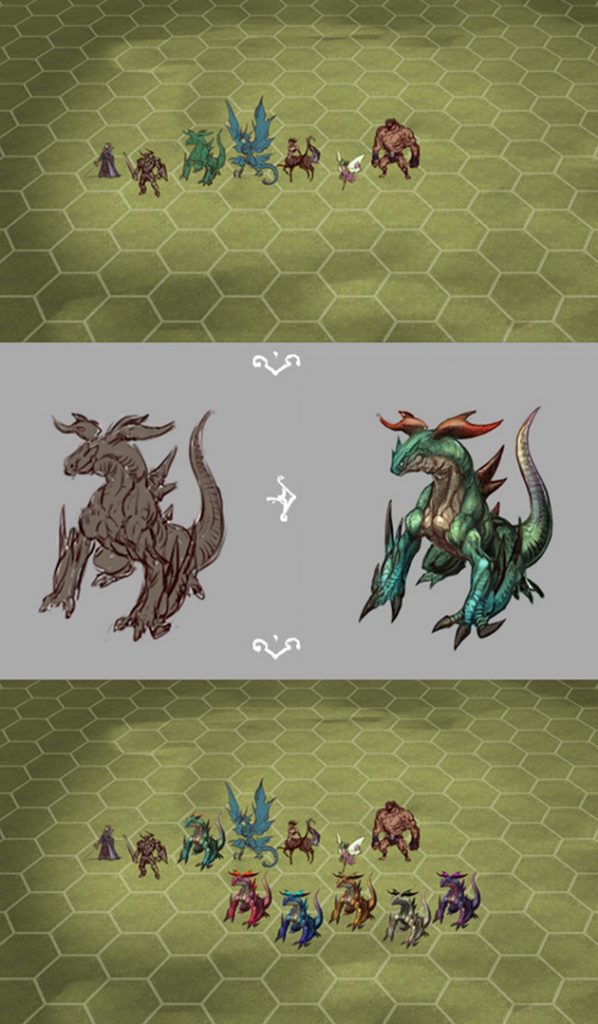Hello everyone! I’m Igarashi, the producer of Brigandine: The Legend of Runersia.
This letter will be about the monsters in the game as well as the concepts and themes behind them.
Monsters are very important in this game, as they make up the main bulk of your combat troops.
With more than 50 types of unique monsters, it’s going to be difficult to measure them all with one yardstick.
Some monsters may embody your battle strategies or the troop composition you favor.
Some, you may give affectionate nicknames and keep them with you until you achieve continental conquest.
What sort of monsters can be summoned in Runersia? Download Trial Mode now to see for yourself!
Wondering what monsters to prioritize in this game? The short answer is that it depends on your play style.
In this letter, we’ll look at the development process that lead to the birth of the monsters in the game.
Mr. Jin Tamura, art director for monster design and illustration, will walk us through the process.
********************************************
Hi everyone! This is Tamura.
I’m very grateful to have this chance to write to everyone via the Producer’s Letter column.
Allow me to explain the work that went into the game’s monster designs along with some illustrations.
■ Principles of Monster Design
One principle is that there should be enough variety to make classic RPG fans recall scenes of monster wars.
For familiar monsters like dragons and wyverns, visuals should reflect the most commonly accepted portrayals.
At the same time, the monsters should be shaped in a way that is uniquely Brigandine.

・ Dragon
This was the test unit for many design processes, like how units should look deformed versus full size.
We wanted it to give the impression of a strong, wise, and dignified king.
This isn’t a game you can win with dragons alone, but having one in your platoon is definitely reassuring.

・ Wyvern
Less authoritative than dragons, it is easier to add avian or reptilian elements to the designs of wyverns.
Surprisingly, a wyvern’s weapon isn’t its beak or claws, but its powerful tail!
Watch as it uses its tail like a powerful whip to slice through enemies!

・ Cyclops
Rough and wild, but by no means inferior. You could ask for no better friend to watch your back.
(Though it would be nice if they didn’t always deplete the rations…)
We designed this monster with the idea of someone seeing an elephant’s skull for the first time.
The illustration phase is when we firm up design details, while also ensuring the monster’s 3D model
is easily recognizable by shape and/or color from a distance on the battlefield.
The Switch’s screen is about 14 x 8 cm. Up to 42 units—allies and enemies combined—can be deployed at once.
That’s a lot of 3D models on the screen! Due to the nature of the game, you often have many units
gathering in one spot. Sometimes, up to 30 different units can be on the screen at the same time.
There aren’t a lot of 3D games with this feature.
That’s why, right from the start, designers were consistently asked to ensure monster types were
easily recognizable even when they’re positioned in a tightly packed space around the player.
Symbolic monster parts were therefore very important elements to plan for during the initial design phase.

・ Large heads, small faces
Enlarging a unit’s head in so-called “SD” style is an effective way to ensure its visibility on the field.
But we also wanted them to look cool with realistic body proportions in line with the Brigandine style.
That said, it’s sometimes easier to recognize an SD-style silhouette from a distance.
So although a little irregular, some monsters like dragons and cyclops do not have large horns on their heads.
By moving the horns to the top of the neck, the head will thus look proportionally larger from a distance.
As always, thank you for reading!
The next letter will be a continuation of the game’s monster design concepts. Don’t miss it!

